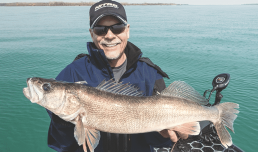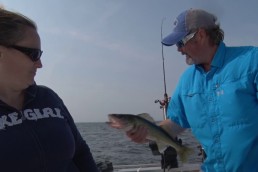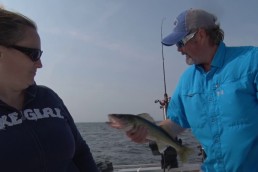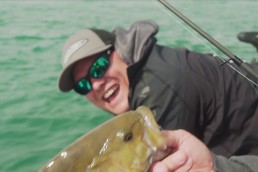Refine Your Rig to Take Total Boat Control
SHARE THIS POST
While current and wind can make for a great bite, these factors can also be a nightmare for positioning a boat. Being in complete control when we’re chasing walleyes isn’t always easy. This type of fishing was very tiring and more of a hands-on job in the past when you had to put an anchor out, bring it up, and then toss it out again for a slight adjustment. It also meant having to put a foot on the pedal of the bow-mount trolling motor constantly to make adjustments to the speed of the kicker motor. There were even days we had two drift socks out and still couldn’t go slow enough for our presentation to work.
But the design of your boat can impact how well you can control it in adverse conditions.
There are two things to look at when purchasing a boat. First, it should sit level in the water so any wind will affect the whole boat, and not just one part of it like the bow. This is dependent on the boat’s design, like tank placement, battery placement, floatation and its hull design.
It’s also important to have a boat with a good keel so it tracks better in water. When we’re trolling sideways in the wind or into the wind the boat won’t wander as much because the keel will keep tracking and hold the boat on course. You can often tell how well a boat tracks by running it backward and turning. If the boat just slips backward and doesn’t follow the engine it probably won’t track well. If a boat follows the engine and can make quick turns going backward, it then means that the vessel does track well.
Advances in technology have really changed the walleye game when it comes to boat control, making it easier to position a boat. This also keeps us from suffering from fatigue like we did in the past.
One of our favorite boat control features is the “Anchor Mode” on our MotorGuide Xi5 bow-mount trolling motor. This comes in handy when casting jigs or Shiver Minnows. Instead of having to put out an anchor, now, with just the click of a button, the motor will act as the anchor and hold us in place while we work a spot. Not only does this eliminate the splash and commotion associated with a traditional anchor, we can also easily position the boat right where we want it to be.
If we’re working a shoreline or bridge pillar, a feature that works great in conjunction with out improved positioning the is “Jogging” mode. With the touch of a button we can move in 5-foot increments, forward, backward or sideway and the motor will also then re-anchor. If we want to move 10 feet over we just click it twice.
Are you enjoying this post?
You can be among the first to get the latest info on where to go, what to use and how to use it!
You can also connect a Lowrance HDS sonar/GPS unit through the MotorGuide Gateway. This system has is a cord that uses the NMEA Network port so you can control your trolling motor right from your unit. This allows you to “tell” the trolling motor to anchor on a specific waypoint. Or, you can move the cursor to a spot on the map and the motor will go there.
Another boat-control feature is “Heading Lock” when pulling regular or spinner rigs on bottom-bouncers. When fishing with this presentation it’s important to keep your bait moving. If you make a sharp turn or slow down too much the bait will fall to the bottom. You can point the motor in the direction you want it to go. The motor does all the work to keep you on course at the desired speed. If you want to move deeper or shallower, just click a button to turn the motor in the new direction. As it starts to head in that new direction the motor will actually straighten out, cutting boat control in half with smooth turns so baits don’t drop to the bottom.
A Power-Pole is also ideal for control. This is an apparatus that mounts on the transom of the boat on the opposite side of the kicker motor. When we’re fishing in less than 8 feet we can press a button to drop the tool down, anchoring us in place. When in more than 8 feet of water we rely on a bow-mount trolling motor with the holding-power mode mentioned earlier. If you have a Power-Pole, use the available Drift Paddle attachment that goes on the spike to create drag. If we’re trolling in open water in early summer and are using spinners and the wind is at 15 to 20 mph and we’re moving with the wind, it becomes difficult to maintain an ideal slower speed for the spinners because the gusts are pushing us. This attachment can be deployed into the water and create drag that helps slow down our trolling speed. The amount of drag it creates can also be controlled by how far down one lowers the paddle in water. If we deploy it only halfway, it slows us down a little. But by deploying it all the way down into the water we have actually been able to slow the boat down as much as 1 to 1.25 mph when trolling with the bigger engines.
Another advantage is when the Paddle is down it dramatically decreases the “surge” effect waves have on the boat as we troll. That’s a big deal, especially when trolling spinners, as surges can affect how the spinners are running. In dingy water, this can make it difficult for fish to track down your baits. By eliminating or at least lessening the surge, the spinners can run truer and be more effective.
The attachment to the transom is also useful when performing a controlled drift, as it has seven quick-change positions that cover a full 180 degrees that allows you to set a paddle at any angle you need to help the boat drift on the path you want it to.
We can control a boat’s path from a bow-mount trolling motor. When we need to move in or out on a break, the Drift Paddle cuts through the water so positioning is easier than when dragging a drift sock. By drifting with it off the back and steering with the bow-mount trolling motor up front you get the control of the your boat back.
By incorporating technology into your fishing you can have a less stressful day on the water and instead take control of your next big bite.
MWO
SHARE THIS POST
Did you enjoy this post?
You can be among the first to get the latest info on where to go, what to use and how to use it!
MWO
We believe being outdoors is good. With more than 1,000 articles each year, MidWest Outdoors magazine is all about sharing outdoor experiences with you—where to go, what to use and how to use it… whether you’re close to home or on that trip of a lifetime.



